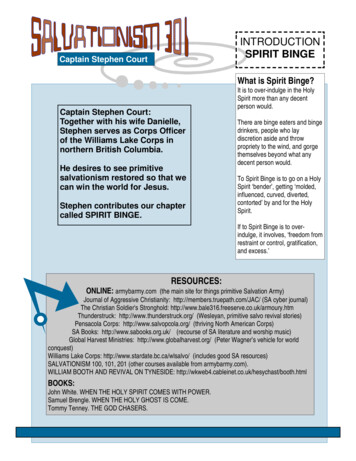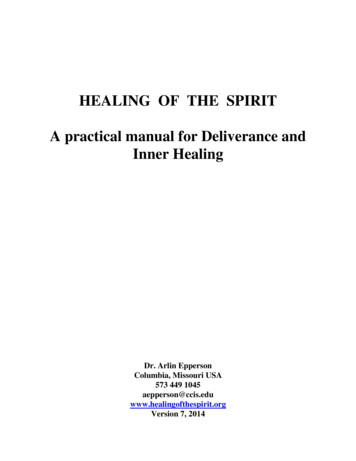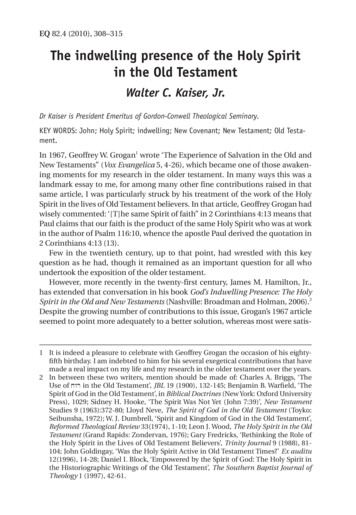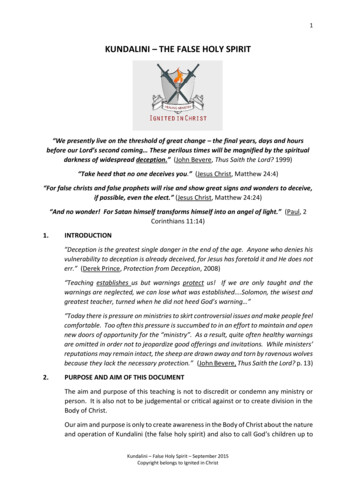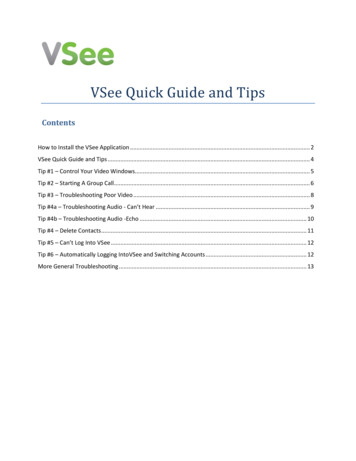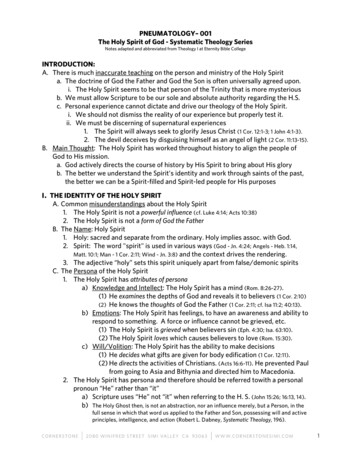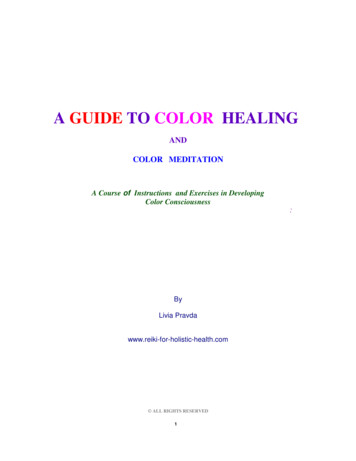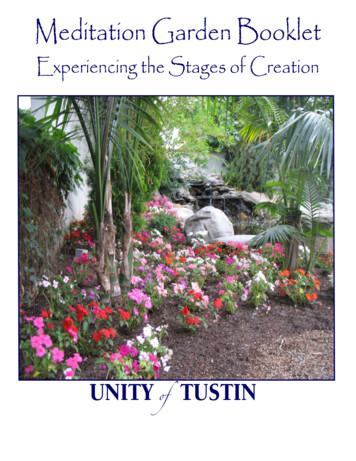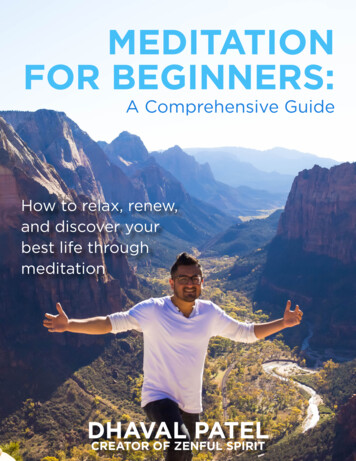
Transcription
MEDITATIONFOR BEGINNERS:A Comprehensive GuideHow to relax, renew,and discover yourbest life throughmeditationDHAVALPATELCREATOR OF ZENFUL SPIRIT
Table of Contents
ME D I TATI ON FO R B EGINNERS: A COMP REHENSIV E GUIDEadded last3
ME D I TATI ON FO R B EGINNERS: A COMP REHENSIV E GUIDEINTRODUCTION:What is Meditation?4
ME D I TATI ON FO R B EGINNERS: A COMP REHENSIV E GUIDEWhen you hear the word “meditation”, what do you think? Do youthink of a bearded Tibetan monk sitting on a mountaintop? Orperhaps a serene yogi sitting in a candlelit room chanting “om”?Well, those are certainly ways that you could meditate, but there’s a whole lotmore to it than that.Meditation can mean many different things to many different people. Perhaps aneasier approach to start with is to clarify what meditation is not. It is not exclusiveto one sector of society or a specific type of person or culture. Meditation is openended, free, available to anyone, and offers great benefits.Far from being meant to empty your mind, meditation is really meant to connectyou to the infinite source, beyond the mind. It’s a beautiful practice that can enrichyour life, bring you closer to others, and improve your health.Why not see what benefits this practice can offer you? This guide is intendedto introduce meditation in a way that is accessible to everyone, so that you canexplore this gratifying practice in a way that will nurture your life and connect youto others.5
ME D I TATI ON FO R B EGINNERS: A COMP REHENSIV E GUIDEPART 1:Meditation 1016
ME D I TATI ON FO R B EGINNERS: A COMP REHENSIV E GUIDEWhy Meditate?If you’re serious about personal development (and I’m assuming that is why you’rehere!), sooner or later you’ve got to get serious about meditation.You can work hard to be physically fit and healthy, to reach your career andfinancial goals, and achieve all the trappings of worldly success—but the fact isthat if you don’t find peace within yourself, you’ll never be truly happy.To the untrained mind, nothing is ever good enough. The ego will always demandmore.That’s where meditation comes in the picture.Through meditation, you realize that you are not your ego, your mind, or yourpersonality. You are the limitless ocean of pure awareness behind it. This realizationis the key to experiencing true joy and contentment, and reaching your highestpotential in all areas of life.The purpose of this book is to provide a broad answer to the question “whymeditate?”. In this book, I’d like to share with you some of the insights I’ve gainedfrom years of practicing meditation. Whether you’re a newbie, or have been atit for some time, I’m sure these tips will help you to deepen your practice, andexperience new levels of inner peace and freedom.7
ME D I TATI ON FO R B EGINNERS: A COMP REHENSIV E GUIDEGetting Started:Meditation BasicsCongratulations! If you’ve read this far, that indicatesthat you are ready to embark on the journey of alifetime, into a meditative practice. Welcome!But before we get too deep, let’s go over the basics to make sure we’re all on thesame page.Getting started with meditation can be an intimidating prospect. There are literallydozens, maybe hundreds, of different ways to meditate—from transcendentalmeditation to tai chi. But for many, the easiest and most recognizable way to getstarted with meditation is silent, seated meditation. It’s a great introduction to thepractice, and simple to get started. Here’s how, in 5 easy steps.8
ME D I TATI ON FO R B EGINNERS: A COMP REHENSIV E GUIDEHow to Get StartedWith Seated Meditationin 5 Easy StepsStep 1: Prepare Your Space.First things first: select your spot. Find somewhere quiet and peaceful, where youwon’t be disturbed during your meditation. This might be your bedroom, homeoffice, or anywhere that you can close the door and find uninterrupted solitude. Asyou practice meditation, it will become easier to practice anywhere, but as you arefirst getting started, quiet and solitude are very beneficial.Once you’ve settled on a location, make sure that your meditation spot is neatand clean. A messy, cluttered space can make it harder to relax and focus. Whilenot required, you might also find it helpful to set the mood by lighting a candle9
ME D I TATI ON FO R B EGINNERS: A COMP REHENSIV E GUIDEor stick of incense, or playing some soft, ambient music—whatever helps you get“in the zone.”Step 2. Set a Goal.Starting a meditation practice can be challenging to people, especially in our fastpaced world. I find that it is extremely helpful to decide in advance how longyou are going to practice, so that you have accountability from the beginning. Irecommend 20-40 minutes per session, depending on how comfortable you are inyour practice; adjust as needed.It’s important to note that distractions are inevitable, and that is okay. Do whatyou can to minimize them (turn off your phone, let your roommates / family knowwhat you’re up to, etc). If you are interrupted for whatever reason, just sit backdown and finish your session as soon as you can.The biggest hurdle by far, especially in the beginning, is not distractions, but yourown mind and restlessness. The ego can’t stand sitting quietly, doing nothing, andit will come up with an endless list of things you should or could be doing instead.Don’t give in. Set a timer, or a stopwatch, or an alarm on your phone, and don’tdismiss your meditation until your settled-upon time has been reached.Step 3. Get Comfortable.When I say “get comfortable”, I am speaking in the literal sense. Posture isimportant in meditation, for many reasons. It helps you breathe easier and deeper.It helps the flow and circulation of blood and energy. Perhaps most importantly,sitting properly will help to minimize aches, pains and discomfort.There is not one correct way to sit; this depends on your body type, bone structure,and constitution. You can sit on the floor, on a cushion or a bench. You can sitin a chair, or even stand up if that’s easier. The important thing is not to slouch,or lean against anything. You should be relaxed yet poised, loose yet balanced,comfortable but alert.Pay attention to any pain or discomfort in your back or your legs, and makeadjustments as necessary. It takes time, but eventually you will find the “sweet10
ME D I TATI ON FO R B EGINNERS: A COMP REHENSIV E GUIDEspot,” where your spine is erect, but not rigid; straight, but not stiff. The perfectbalance of effort and ease.Step 4. Follow the Breath.Bring your attention to your breathing. Focus on the sensations: the air flowing inand out of your mouth and nostrils; the rise and fall of your chest, the filling andemptying of your belly.Don’t try to control your breathing. No need to deliberately breathe slow ordeep (although this will often happen on it’s own, as you become aware of yourbreathing). Just pay attention, and feel the rhythm, the ebb and flow. There arebreathing exercises which we will explore later on, but for now, just observe.Step 5. Just Relax.Easier said than done, right? But relaxing is possible, and the first step is awareness.Start by becoming aware of any places in your body where there is tension ordiscomfort. We have a tendency to store stress in our bodies, particularly in thelegs, shoulders, back, neck and face.Each time you breathe out, imagine that tension flowing out of your body. Withevery breath, release and relax, until you feel entirely comfortable and at ease.This can take some time, especially as you are first getting started. Generally, themore often you practice, the quicker and easier it will be to let go of stress andsink into a state of peace and relaxation.11
ME D I TATI ON FO R B EGINNERS: A COMP REHENSIV E GUIDERefining Your PracticeOkay, so you’re sitting still, with your spine straight,eyes closed, totally relaxed.now what?First of all, congratulations! Not many people even manage to get this far. Sittingstill for any length of time is an accomplishment in and of itself. It requires realdiscipline and willpower to overcome the restless mind, and just be still. Bravo.Now, it’s time to refine your practice so that you can really get to the real work:training the mind, and cultivating patience, inner peace, compassion and truehappiness. Here are seven tips and methods you can use to refine and take yourpractice to the next level:12
ME D I TATI ON FO R B EGINNERS: A COMP REHENSIV E GUIDE1. Focus Your Attention.Every kind of meditation and inner work requires a certain degree of mentaldiscipline, focus, and control. It’s one of the simplest aspects of meditation, yetone of the most difficult to master.Start by focusing your attention on a single thing: usually a mantra, a candleflame, or your breath—and hold to it. When your mind wanders (and it will), simplynotice what distracted you (an itch, a noise, a random thought) and then gentlybring your awareness back to the object of focus.In the beginning, this seems like an exercise in futility. Your attention strays everyfew seconds, and it feels hopeless, frustrating, not to mention boring. But keep atit; you’ll see progress sooner than you think.Your fickle mind becomes more steady. Thoughts and other distractions fade intothe background, where they come and go without pulling you away. Your mantra(or your breath, or whatever you choose) becomes an island, a sanctuary, a calmrefuge that you can retreat to at anytime.2. Expand Your Awareness.Besides concentration, the other essential discipline is mindfulness. In Buddhism,these two are sometimes referred to as “the two wings” of meditation—and likewings, they work together. Opposite, but complementary. Where concentrationis narrow and focused, mindfulness is expansive. Where concentration is onepointed, mindfulness is relaxed and open, taking in all things at once.To practice, simply let your awareness expand and grow. From feeling the breath,let it spread throughout your body. Then to your other senses. And then to yourmind, your thoughts and emotions. When a thought or sense object arises thatpulls you in and absorbs your attention, just notice it and let it go. Return to freeand open awareness.Learn to observe the present moment, and all it contains, without grasping at anyof it. Eventually, you’ll learn to rest in that state, calm and at peace, as thoughtsand other phenomena rise and fall, come and go, in an eternal ebb and flow.13
ME D I TATI ON FO R B EGINNERS: A COMP REHENSIV E GUIDE3. Practice Non-judgment.Meditation is about cultivating pure awareness. As thoughts, and memories, andfeelings flow through your awareness, try not to judge them as good or bad, rightor wrong.Simply observe the activity of the mind, without labeling it. Most importantly,don’t judge yourself based on what you think. You aren’t a good person for having“good thoughts,” or a bad person for having “bad thoughts.”You don’t get to choose or control what comes into your head. You are not your mind.Listen to your thoughts like you’d listen to the birds, or the sound of the wind,or the ticking of the clock. Watch your memories and fantasies unfold like you’dwatch a group of kids playing in a field. It’s just mental words and movies. Itdoesn’t define you. It doesn’t mean anything.4. Make Friends With the Mind.In spite of popular belief, the goal of meditation is not to silence the mind. Themind is not an enemy to be overcome, but—with the right attitude and training—can be an ally, and a powerful tool.Whether you are practicing concentration or mindfulness, the ceaseless streamof thought will distract you, hypnotize you, and capture your attention again andagain. But if you watch closely, you will see many of the same thought patternskeep repeating, over and over.Pay attention, for there are lessons to be learned in this patterns. These recurringthoughts (or memories, dreams, fantasies, etc) are here to teach you. They holdthe keys to your mental prison—the deeply held beliefs, crippling fears, andsubconscious programming that keeps you from realizing your infinite potential.Don’t resist your thoughts, even the unpleasant ones. Don’t fight your mind; rather,befriend it. Welcome each thought as it comes, and invite it to reveal whatever ithas to teach you. Get to know your inner workings, why you do what you do, whyyou are the way you are.14
ME D I TATI ON FO R B EGINNERS: A COMP REHENSIV E GUIDELook within, into the deep, dark corners of your mind, and bring them into thelight. Make the unconscious, conscious.5. Let Go of Your “Stories”.Your fears, judgments, and limiting beliefs—all those recurring thought patternsyou uncover during meditation—form your most basic concepts of “self” (who youthink you are) and “other” (the rest of the world, the way it works, what it wants orexpects from you). They literally shape your life, and how you behave and relateto others.But they aren’t true.They’re just stories. They seem true because you believe them. They color anddistort your perception of reality, affecting how you see yourself, others, events.basically, everything. If you really want to be free, to cast off your doubts and fears,to break through your barriers and limitations, you’ve got to stop believing inthem.Again, that doesn’t mean denying them, resisting them, or fighting to make themgo away. When these old stories come to your attention, simply smile and silentlysay, “I don’t believe you. That isn’t true.”Then let it go. Repeat as needed.6. Shift Your Identity.Most people go through life believing that they are their ego, their mind, theirpersonality. They identify with the voice (or voices) in their head, that’s constantlytalking, analyzing, judging, labeling, worrying, planning, remembering.rinse andrepeat, it goes on and on.But it isn’t true.Meditation offers us a way to free ourselves from that great lie. We can learn tostop identifying with the scared little ego, and realize the empowering truth ofwho and what we really are.15
ME D I TATI
MEDITATION FOR BEGINNERS: A Comprehensive Guide DHAVAL PATEL CREATOR OF ZENFUL SPIRIT How to relax, renew, and discover your best life through meditation

